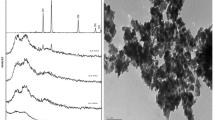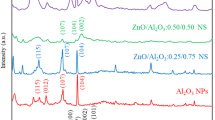Abstract
We report preparation of Titanium dioxide (TiO2) nanoparticles doped PVA/PVP polymer nanocomposites by solvent casting technique. FTIR spectra and XRD studies signify the structural modifications taking place in the nanocomposites. The optical energy gap decreases by the addition of TiO2 nanoparticles. The mechanical properties such as tensile strength and Young’s modulus are enhanced by the addition of Titanium dioxide (TiO2) nanoparticles. The Fluorescence studies indicate that photoluminescence intensity is maximum for 4 wt% doping concentration of TiO2. The AFM analysis provides information about the surface roughness of the polymer film. The dielectric plot shows that the dielectric constant increases up to 12 wt% doping of TiO2, a further increase in the doping concentration results in the reduction of dielectric constant. The dielectric constant decreases with an increase in the frequency for all the films. The above properties show TiO2 doped PVA/PVP nanocomposite films are a prominent material for potential applications.












Similar content being viewed by others
References
Nichoa ME, García-Escobar CH, Arenas MC, Altuzar-Coelloc P, Cruz-Silvaa R, Güizado-Rodríguez M (2011) Influence of P3HT concentration on morphological,optical and electrical properties of P3HT/PS and P3HT/PMMA binary blends. Mater Sci Eng B 176:1393–1400
Liao CZ, Bao SP, Tjong SC (2011) Microstructure and fracture behavior of Maleated high-density polyethylene/silicon carbide nanocomposite toughened with poly(styreneethylene-butylene-styrene) triblock copolymer. Adv Polym Technol 30:322–333
Su F-H, Zhang Z-Z (2009) Friction and Wear behavior of glass fabric /phenolic resin composites with surface-modified glass fabric. Appl Polym Sci 112:594–601
Ramesan MT, Varghese M, P J, Periyat P (2018) Silver-doped zinc oxide as a nanofiller for development of poly(vinyl alcohol)/poly(vinyl pyrrolidone) blend nanocomposites. Adv Polym Technol 37(1):137–143. https://doi.org/10.1002/adv.21650
Mano V, Silva MESR e, Barbani N, Giusti P (2004) Binary blends based on poly(N-isopropylacrylamide): miscibility studies with PVA, PVP, and PAA. Appl Polym Sci 92:743–748
Wang N, Yu J, Ma X (2008) Preparation and characterization of compatible thermoplastic dry starch/poly(lactic acid). Polym Compos 29:551–559
Wang X, Bazuin CG, Pellerin C (2015) Effect of small molecule hydrogen-bond crosslinker and solvent power on the electro spinnability of poly(4-vinyl pyridine). Polymer 57:62–69
Nurfatimah B, Ching YC, Luqma CA, Chantara TR, Nor A (2015) Thermal and dynamic mechanical properties of grafted kenaf filled poly(vinyl chloride/ethylene vinyl acetate composites). Mater Des 65:204–211
Ma R, Xiong D, Miao F, Zhang J, Peng Y (2010) Friction properties of novel PVP/PVA blend hydrogels as artificial cartilage. J Biomed Mater Res Part A 93:1016–1019
Ma R, Xiong D, Miao F, Zhang J, Peng Y (2009) Novel PVP/PVA hydrogels for articular cartilage replacement. Mater Sci Eng 29:1979–1983
Mallakpour S, Jarahiyan A (2017) Enhancement of poly(vinyl alcohol)–poly(vinyl Pyrrolidone) blend properties using modified copper (II) oxide and ultrasonic irradiation. Polym-Plast Technol Eng 56(10):1059–1067
Kubo S, Kadla JF (2003) The formation of strong intermolecular interactions in immiscible blends of poly(vinyl alcohol) (PVA) and lignin. Biomacromolecules 4:561–567
Ben Doudou B, Vivet A, Chen J, Laachachi A, Falher T, Poilâne C (2014) Hybrid carbon nanotube—silica/ polyvinyl alcohol nanocomposites films: preparation and characterisation. J Polym Res 21:420. https://doi.org/10.1007/s10965-014-0420-9
Baraker BM, Lobo B (2016) Experimental study of PVA–PVP blend films doped with cadmium chloride monohydrate. Indian J Pure Appl Phys 54:634–640
Abdelrazek EM, Elashmawi IS, El-khodary A, Yassin A (2010) Structural, optical, thermal and electrical studies on PVA/PVP blends filled with lithium bromide. Curr Appl Phys 10:607–613
Rathod SG, Bhajantri RF, Ravindrachary V, Sheela T, Pujari PK, Naik J, Poojary B (2015) Pressure sensitive dielectric properties of TiO2 doped PVA/CN-li nanocomposite. J Polym Res 22:6. https://doi.org/10.1007/s10965-015-0657-y
Goswami A, Bajpai AK, Bajpai J, Sinha BK (2017) Designing vanadiumpentoxide-carboxymethyl cellulose/polyvinyl alcohol-based bionanocomposite films and study of their structure, topography, mechanical, electrical and optical behavior. Polym Bull 75:781–807. https://doi.org/10.1007/s00289-017-2067-2
Wang YJ, Kim D (2007) Crystallinity, morphology, mechanical properties and conductivity study of in situ formed PVdF/LiClO4/TiO2 nanocomposite polymer electrolytes. Electrochim Acta 52:3181–3189
Kiesow A, Morris JE, Radehaus C, Heillman A (2003) Behavior switching behavior of plasma polymer films containing silver nanoparticles. J Appl Phys 94:6988–6990
El-Ahdal MA (2000) Radiation effect on the molecular structure of dyed poly(vinyl alcohol). Int J Polym Mater 48(1):17–28
Abd El-Kader KAM, Abdel Hamied SF (2002) Preparation of poly(vinyl alcohol) films with promising physical properties in comparison with commercial polyethylene film. J Appl Polym Sci 86(5):1219–1226
N.B. Rithin Kumar, Vincent Crasta, and B. M. Praveen(2014) Advancement in Microstructural, Optical, and Mechanical Properties of PVA (Mowiol 10-98) Doped by ZnO Nanoparticles, Hindawi Publishing Corporation Physics https://doi.org/10.1155/2014/742378
Bhajantri RF, Ravindrachary V, Poojary B, Ismayil AH, Crasta V (2009) Studies on fluorescent PVA + PVP + MPDMAPP composite films. Polym Eng Sci 49:903–909. https://doi.org/10.1002/pen.21341
Mott NF, Devis EA (1979) Electronic process in non-crystalline materials2nd edn. Oxford University Press, Oxford
Tauc J (1972) Optical properties of solids. In: Abeles F (ed) Optical Properties of Solid, North-Holland, Amsterdam, p 277
Abdullah OG, Tahir DA, Ahmad SS, Ahmad HT (2013) Optical properties of PVA:CdCl2.H2O polymer electrolytes. IOSR-JAP 4:52–57
Sunil G, Rathod RF (2016) Bhajantri , V. Ravindrachary , Jagadish Naik , D. J. MadhuKumar high mechanical and pressure sensitive dielectric properties of GrapheneOxide doped PVA nanocomposites. RSC Adv 6:77977–77986. https://doi.org/10.1039/C6RA16026C
Khadheer pasha SK, deshmukh k, ahamed m B, Chidambaram k, Mohanapriya m K, raj n A n (2015) Investigation of Microstructure, Morphology, Mechanical, and Dielectric Properties of PVA/PbO Nanocomposites. Adv Polym Technol 36:352–361. https://doi.org/10.1002/adv.21616
Bhat TS, Devan RS, Mali SS, Kamble AS, Pawar SA, Kim IY, Ma YR, Hong CK, Kim JH, Patil PS (2014). J Mater Sci Mater Electron 25:4501–4511
Srivastava S, Kumar S, Singh VN, Singh M, Vijay YK (2011) Synthesis and characterization of TiO2 doped polyaniline composites for hydrogen gas sensing. Int J Hydrog Energy 36:6343–6355
Zidan HM (2003) Structural properties of CrF3, and MnCl2 -filled poly (vinyl alcohol) films. J Appl Polym Sci 88:1115–1120
Baraker BM, Lobo B (2017) Spectroscopic analysis ofCdCl2 doped PVA–PVP blend films. Can J Phys 95(8):738–747. https://doi.org/10.1139/cjp-2016-0848
M. Cuba, G. Muralidharan N (2014) Enhanced luminescence properties of hybrid Alq3/ZnO (organic/inorganic) composite films. J Lumin 156:1–7
Kumar N.B R, Crasta V, Praveen BM, Kumar M (2015) Studieson structural, optical and mechanical properties of MWCNTs and ZnO nanoparticlesdoped PVA nanocomposites. Nanotechnology Rev 4(5):457–467. https://doi.org/10.1515/ntrev-2015-0020
Khan M, Khan AN, Saboor A, Gul IH (2017) Investigating mechanical, dielectric, and electromagnetic interference shielding properties of polymer blends and three component hybrid composites based on polyvinyl alcohol, polyaniline, and few layer grapheme. Polym Compos 39:3686–3695. https://doi.org/10.1002/pc.24398
Ravati S, Favis BD (2010) Low percolation threshold conductive device derivedfrom a five-component polymer blend. Polymer 51:3669–3684
Al-Saleh MH, Sundararaj U (2008) An innovative method to reduce percolation threshold of carbon black filled immiscible polymer blends. Compos Part A 39:284–293
Mao C, Zhu Y, Jiang W (2012) Design of Electrical Conductive Composites: tuning the morphology to improve the electrical properties of graphene filled immiscible polymer blends. ACS Appl Mater Interfaces 4:5281–5286
Zhu L (2014) Exploring strategies for high dielectric constant and low loss. Polymer dielectrics. J Phys Chem Lett 5:3677–3687
Mahendia S, Tomar AK, Kumar S (2011) Nano-ag doping induced changes inoptical and electrical behaviour of PVA films. Mater Sci Eng B 176:530–534
Rithin Kumar NB, Crasta V, Praveen BM (2016) Dielectric and electric conductivity studies of PVA (Mowiol 10-98) doped with MWCNTs and WO3 nanocomposites films. Mater Res Express 3:055012
Mahendia S, Tomara AK, Kumara S (2010) Electrical conductivity and dielectric spectroscopic studies of PVA–ag nanocomposite films. J Alloys Compd 508:406–411
Bhajanti RF, Ravindrachary V, Harisha A, Ranganathaiah G, Kumaraswamy GN (2007) Effect of barium chloride doping on PVA microstructure: positron annihilation study. Appl Phys A Mater Sci Process 87:797–805
Devi CU, Sharma AK, Rao VVRN (2002) Electrical and optical properties of pure and silver nitrate-doped polyvinyl alcohol films. Mater.Lett. 56:167–174
Su S-J, Kuramoto N (2000) Processable polyanilinetitanium dioxide nanocomposites: effect of titanium dioxide on the conductivity. Synth Met 114:147–153
Rao V, Ashokan PV, Shridhar MH (2000) Studies of dielectric relaxation and a.C. Conductivity in cellulose acetate hydrogen phthalate–poly(methyl methacrylate) blends. Mater Sci Eng A 281:213–220
Kiesow A, Morris JE, Radehaus C, Heilmann A (2003) Switching behavior of plasma polymer films containing silver nanoparticles. J Appl Phys 94:6988–6990
Phang SW, Tadokoro M, Watanabe J, Kuramoto N (2018) Synthesis, characterization and microwave absorption property of doped polyaniline nanocomposites containing TiO2 nanoparticles and carbon nanotubes. Synth Met 158:251–258
Stamate MD (2000) Dielectric properties of TiO2 thin films deposited by a DC magnetron sputtering system. Thin Solid Films 372:246–249
Author information
Authors and Affiliations
Corresponding author
Additional information
Publisher’s note
Springer Nature remains neutral with regard to jurisdictional claims in published maps and institutional affiliations.
Rights and permissions
About this article
Cite this article
Rajesh, K., Crasta, V., Rithin Kumar, N.B. et al. Structural, optical, mechanical and dielectric properties of titanium dioxide doped PVA/PVP nanocomposite. J Polym Res 26, 99 (2019). https://doi.org/10.1007/s10965-019-1762-0
Received:
Accepted:
Published:
DOI: https://doi.org/10.1007/s10965-019-1762-0




